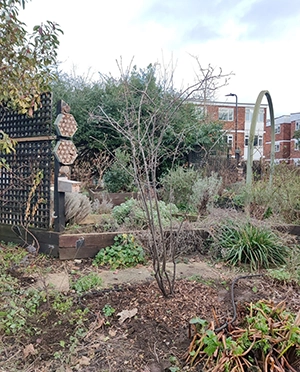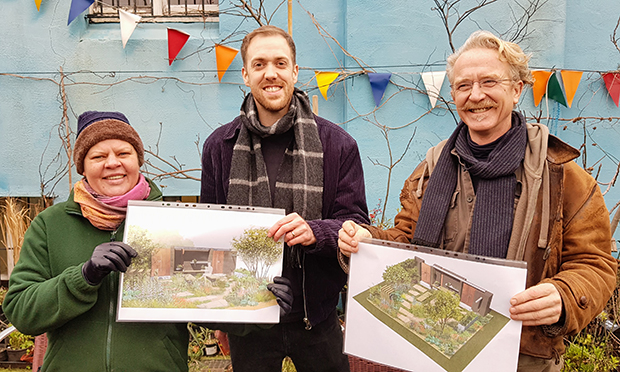The Citizen Gardener: Ecological gardening – do it for baby Leoh

Baby Leoh. Photograph: courtesy Steph Goward
A baby came into my life recently. He’s the son of two of my best friends and whilst strolling through Hackney Downs with him in his buggy, I wondered what it might look like when he and his fellow babies are grown up.
I am and always have been an advocate for ecological gardening practices and meeting this sweet little bundle made me think more urgently about how our relationship with the natural world around us today will impact the babies of Hackney in the years to come. We are after all, only Hackney’s current custodians.
Ecological, permacultural, organic, wildlife-friendly, call it what you will, these ideas are all centred on the same core principle: work with, not against nature. Contrary to the actions and instructions of many busybody horticulturalists, plants are actually very capable of looking after themselves without us humans meddling.
Gardening needn’t be about our control over nature through the use of synthetic fertilisers, herbicides and pesticides. It is possible to create a space for aesthetic and productive purposes that also encourages biodiversity. And, with the total area of gardens in the UK amounting to approximately 433,000 hectares (that’s about a fifth of the size of Wales), we have a colossal resource of national significance for the thousands of generalist species that can live in gardens.
While ecological gardening may seem like the more expensive, labour-intensive option, it is actually quite the opposite.
The key idea is to leave nature to do its thing. When you choose a less invasive gardening practice, the main activity is observation, so more time to sit back in your wild sanctuary. And, in so doing, you will attract more animals – pollinators, hedgehogs, birds – which provide endless free entertainment.
Here are a few ideas to get your started:
Use what’s already available

Garden undergoing a redesign led by Miria Harris. Photograph: courtesy Steph Goward
Last week I found myself walking up Mare street with a nine-foot Amelanchier precariously balanced on my bike and a wisteria in my backpack, its long tendrils wrapped around my waist.
Being Hackney, no one batted an eyelid, I wasn’t even in the top 10 per cent of interesting sights on Mare street that day.
I was on my way home from a plant-saving mission with Siobhán, the garden manager at St Mary’s Secret Garden. We had visited a house in London Fields that is undergoing a garden overhaul by Hackney designer Miria Harris. Miria is committed to making it a zero-waste project so reached out to her instagram followers and invited anyone who wanted some free plants to come and fill their boots. Aside from an excellent business idea (someone please make an app!) rehoming these plants was a joyful way of gardening sustainably and saving them from the dump.
On a smaller scale, propagating plants is a way of sharing what you have without damage or waste. It is also really easy and can be done without a garden. Houseplant cuttings make excellent presents, and seed swaps are a lovely way to meet other green-thumbed folk.
The same notion of using what’s around you can be applied to garden fertiliser.
Last weekend I went for stroll around Hackney marshes on the hunt for comfrey. I snipped a few leaves, covered them in water and have left the concoction in a bucket outside. Within a week it will be a perfectly balance fertiliser that works for most plants given its natural balance of phosphorous, potassium and nitrogen. For plants that like a little more nitrogen, you can make a nettle fertiliser, and for those that like potassium, banana peels soaked in the same way works wonders.
There’s no such thing as garden waste
Refrain from gathering up fallen leaves to burn or throw away. You can rake them straight into the beds for an easy mulch, add them to your compost, or pile them up separately and leave them alone for a year to make leaf mould. Leaf mould rots down fairly quickly so won’t take up too much space. Combined with the soil, it offers a plethora of benefits. It is the perfect environment for mycorrhizal fungi to thrive, which allow plants to better take up nutrients and communicate with each other. It also improves that all important soil structure which helps with drainage and retention.
If, like me, you have been doing a lot of pruning over the past month, you will have a lot of sticks. These can be repurposed as bean poles – hazel and willow work particularly well. Alternatively, you can create a dead-hedge, which are linear piles of twigs, sticks and branches. They are good for wildlife – especially for small mammals and birds – giving them somewhere to shelter that is protected from predators and from the wind and rain. If space is at a premium, you can make mini versions under garden benches or along the railings of a balcony.
Any other waste (aside from pernicious weeds) can be put on the compost. Not only is it deeply satisfying to watch your waste turn into a brilliant growing medium, but making your own allows you to avoid the cost, packaging and environmental impact of bought compost. If you do end up buying the ready-made stuff, be sure to avoid peat-based compost as it’s harvested from ancient bogs which are irreplaceable habitats and carbon sinks.
Mow high, mow less
British gardens are famous for their lawns. If left to grow, they quickly turn to meadow with a surprising number of flowering plant varieties, much to the delight of our endangered pollinators. It doesn’t have to be all or nothing though. ’No Mow May’ is one option. Another is to generally set your blades slightly higher – maybe above the heights of low flowering plants like daisies and buttercups. You can also leave ‘islands’ of long grass or make mazes to play in.
Accept ‘weeds’
An easy way to deal with weeds is to accept some of them. There are those that creep into the garden and add colour, joy and a good source of food for pollinators. And there are the gentler ones, such as daisies, buttercups, dandelions that add beauty to the borders. Indeed, James Wong recently wrote about the scramble among Singaporean gardeners to source dandelion seeds, and the lengths they will go to to have them grow in their tropical climate. Of course, they can spread faster than we would like them to, so a good way of keeping on top of them is to pull them out after flowering but before they go to seed, that way, everyone wins.
Avoid synthetic herbicides, pesticides and fungicides
These chemicals, that are used so widely in the agricultural industry, are bad for humans and wildlife. They do not degrade in the environment and they are made using fossil fuels. There is also a growing body of evidence showing their role in the decline of the nutritional content of our food – down 38 per cent in the UK since the 1950s. What’s more, there really is no need for them, there are natural predators already available in your garden most of which are in decline and would benefit from the food source. Ladybirds, hoverflies and lacewing larvae will eat aphids, while hedgehogs, birds and frogs will eat slugs and snails.
Thorough washing of your tools at the end of each gardening session will work wonders for disease control. There are defences available in the hedgerow too; old thorny branches (like those of the brambles you pull out) can be laid around your veg bed to deter animals from grazing.
Glass cloches placed over your seedlings look chic, keep your plants cosy, encouraging them to grow and will keep slugs from munching.

Designer Andy Smith-Williams (centre) with Core Arts CEO Paul Monks and volunteer Sarah Watt. Photograph: courtesy Core Landscapes
There are copious places to find inspiration for ecological growing around Hackney. Core Landscapes, one of Hackney’s best loved (and fully organic) community gardens, was represented at the RHS Chelsea show last year by Hackney-based garden designer Andy Smith-Williams who won gold. His garden showcased clever wildlife-friendly garden practices such as a water collection system which allowed for the overflow caused by heavy rainfall to filter into a planter packed with moisture-loving plants.
You can check out what Core are up to now at their expanding garden in Homerton. Chelsea promises to showcase even more environmentally friendly gardens this year, so hold tight for coverage of the show this summer.
As ever, one of the best ways to get ideas is by chatting with your green-thumbed friends. I’ve never met a gardener I didn’t like, they’re a friendly bunch, so why not open up a conversation and see what other tips and tricks are out there. Your plants, the animals and Baby Leoh will thank you.
Steph Goward is an ecological gardener and food grower. She is the postcode gardener for E5, a horticultural therapist at St Mary’s Secret Garden, and works with a number of gardening groups across Hackney. You can follow her at @steph_orla_gardens.
